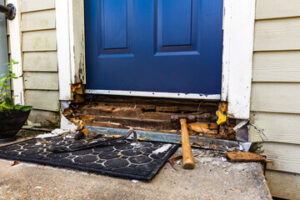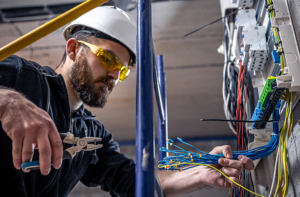When the time comes for septic tank cleaning or pumping, you want to hire the right professionals. Ask about their experience with septic system service and how they keep a homeowner’s septic system working correctly.
Septic Tank Cleaning Perth removes solid waste and floatable sludge from your home’s septic tank. This prevents inconvenient clogs in your drainpipes and protects the environment.

When wastewater leaves your home, it travels to a septic tank for processing. During this process, lighter solids float to the top as scum while heavier waste sinks and compiles into sludge. Separating these two layers ensures that only clean, liquid wastewater enters the drain field for absorption into the soil. This helps prevent clogged pipes and drain field failure. However, when too much sludge builds up in your tank, it can overflow into the yard and cause sewage odors, slow drainage, and even system failure. Regular septic tank pumping helps avoid these problems.
When septic tank cleaning services are performed, all of the sludge and scum inside the tank is removed to ensure that liquid wastewater has room to flow out of the septic system. Professionals use a large tanker truck equipped with a vacuum device to remove the waste and dispose of it safely. They will also carefully inspect the tank to ensure that the system is working properly before they proceed with the pumping.
In addition to removing the solids in the tank, septic tank cleaning services can also help you extend your time between pumpings. A regular septic tank cleaning service will keep sludge levels at or below the preventative drain field level, saving you money in septic tank replacement costs and improving your septic tank’s lifespan.
To perform septic tank cleaning, a professional will insert a hose into each of the tank’s open lids. The hose is then attached to a suction nozzle that pulls the sludge from the tank and directs it to a dumpsite for proper disposal. During this process, the professionals will carefully stir the contents of the tank to break up the sludge and mix it with the liquids in the tank, making it easier to transport out of the tank.
During the pumping and cleaning process, the professionals will also thoroughly clean the septic tank’s walls, baffles, and access ports. They will rinse the interior of the tank with high-pressure water to remove any remaining debris and then seal the access ports securely after cleaning is complete. They will also carefully examine the septic tank components for any damage that may require repairs or replacements.
Prevent Clogs
If you’re on a preventative maintenance schedule, regular septic tank cleaning can save you from clogs, backups and more. You’ll also avoid expensive septic system repairs and replacements from unavoidable wear-and-tear and corrosive substances like sludge, water and gas.
Preventative measures include avoiding flushing items that can’t be broken down by the septic system, such as coffee grounds and baby wipes. It’s a good idea to keep an eye on your septic tank filters, too. These can get full of lint and other debris that isn’t broken down by the tank bacteria.
Septic tank cleaning involves pumping out the sludge and liquid waste, but it’s more involved than just emptying the container. The septic cleaning process includes opening all access points, couplings, inlets and outlets to thoroughly clean the interior of the tank. It also involves checking baffles, aeration inlets, lids and other parts of the septic system to ensure they’re intact.
It’s important to choose a septic tank cleaner with the right equipment to ensure a complete and thorough cleanout of your system. The wrong equipment configuration can damage components and allow solids to fall out, resulting in a less-effective cleaning.
Professional septic tank cleaners use a high-powered vacuum truck and specialized agitation nozzles to break up the sludge into smaller, more manageable pieces. They then transport the material to a licensed and regulated waste treatment facility for safe disposal, which adheres to environmental guidelines.
The first step in the cleaning process is to drain the tank. Before professional septic tank cleaners begin, they check the weather and note if it’s been rainy recently. If so, they may need to wait a few days before pumping the tank to ensure the ground is dry.
The next step is to re-seal the tank, which helps to protect against contamination and odors from outside. They’ll use a special cleaning solution to eliminate any remaining residue in the tank and restore bacterial balance. Then they’ll inspect the septic tank and drain field for any cracks, leaks or structural issues that require repair or replacement.
Fresh Smell
Septic tanks can fill up with sludge and solid waste, which reduces efficiency and storage capacity. When these substances overflow, they flow into the drainage field and contaminate groundwater or cause clogs in homes. Regular septic tank cleaning prevents solid waste buildup and helps extend system life.
Depending on the size of your septic tank and how often it’s used, you may need to have your septic system cleaned at a minimum of two to three times per year. Some homes with large families or frequent use of septic tank-compatible products will require more cleanings. Professionals recommend using septic tank monitoring devices that measure liquid levels to alert you when the tank is close to full or the waste needs pumping.
A septic tank cleaning company will use a truck with specialized vacuum equipment to remove all accumulated waste and sludge from your septic tank’s compartments. A hose is inserted into each manhole, and the contents are drawn into the truck’s pump through a suction mechanism. The technicians also stir the contents of the septic tank to mix up the sludge and liquids, making it easier to pump out and dispose of.
Before beginning septic tank cleaning, technicians inspect the tank’s condition to determine how much work is required. They look for cracks, structural damage, and holes in the tank and baffles. They also note if the inlets and outlets are clear of obstructions and open properly. During the cleaning process, technicians will treat surfaces to control odor and break down solid waste for easy removal and disposal.
The septic tank cleaning company will then transport the collected waste to a sewage treatment plant or landfill, adhering to environmental safety standards. They may then rinse the tank and drain field to eliminate residue and restore optimal septic system performance.
When you’re ready to schedule septic tank cleaning, don’t hesitate. It’s essential to have this service done on a routine basis to avoid overflow and backup issues that can cost you a fortune. Contact a local septic tank cleaning service today to get started.
Improved Drainage
Many homeowners don’t give their septic system much thought until something goes wrong. Then a foul backup indoors or soggy mess in the yard tells them that there’s a serious problem underground. The best way to avoid these problems and prevent costly cleanup services is to keep up with routine septic tank maintenance and inspections.
The septic tank itself is a huge structure that holds and processes waste from your home. Waste enters through a tee into the tank, where anaerobic bacteria break it down and deposit it into the sludge layer for further processing. Over time, this process slows down, leading to the accumulation of sludge and floating scum. The septic tank must be pumped periodically to remove excess waste.
Pumping involves extracting the liquid waste and floating debris from your septic tank using a long, vacuum-like hose. This is a necessary maintenance service, and the frequency depends on the size of your septic tank and how quickly solid materials build up in it. Regular pumping helps maintain proper wastewater treatment and reduces the risk of blockages in the septic system’s drain field.
To complete the pumping process, a professional septic tank pumper first locates and accesses your septic tank. They use a depth gauge to read the tank’s level and determine how much waste needs to be evacuated. Then, they use a large vacuum truck to empty the tank and move the waste to a disposal site. Before leaving, the septic tank pumper checks for any structural damage or leaks in the tank and its baffles.
Cleaning is a more in-depth process that completely resets the septic tank and its internal workings. It’s like hitting the “restart” button. During cleaning, qualified septic cleaners use special equipment to thoroughly scrub the inside of your septic tank, removing all sludge and scum residue and breaking up compacted solids that have settled at the bottom. This thorough and complete process prevents clogs and restores the septic tank’s full liquid waste capacity.
It’s important to understand the difference between septic tank pumping and cleaning to ensure you receive the right service for your home. Septic tank pumping is a necessary but incomplete maintenance service, while cleaning restores the septic tank to its original condition and prevents future problems.








